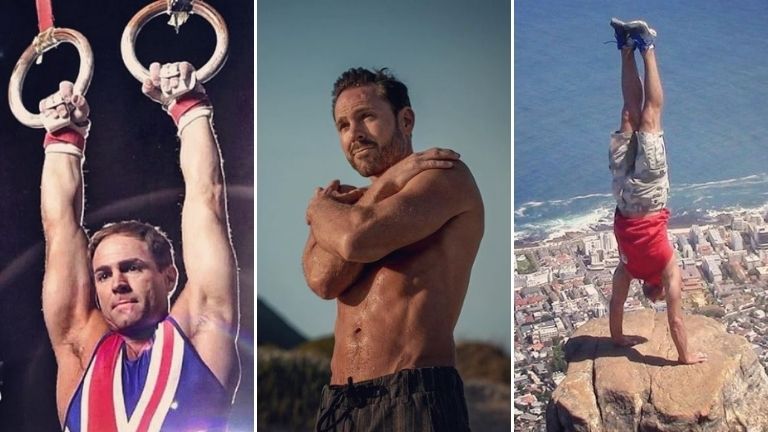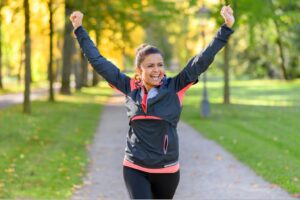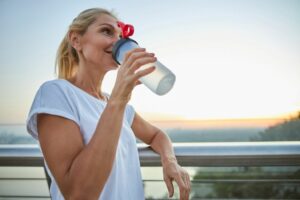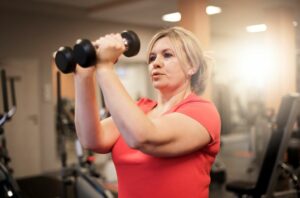Hollywood stuntman and team GB athlete Nicholas Daines, says he is in the best shape of his life aged 50. Here are 10 things he wants you to know about how to get fit in your 50’s
Most people will associate ageing with not being able to maintain fitness, but that is not true. Exercising is your ticket to a happy, healthy, long, and dignified life.
As you get older, keeping fit and healthy is of the utmost importance. Being mobile is a blessing, and living long a gift.
Unfortunately, as you age, your body becomes more susceptible to diseases such as cancer, your bones may become more brittle and you might find that your balance is impaired and so you are more likely to fall over.
The good news is, if you live a healthy lifestyle and stay physically active, you can reduce the risk of developing these cardiovascular diseases and cancer.
Plus, chronic health conditions such as Alzheimer’s or pre-diabetes are less likely to occur if you live a physically active lifestyle.
Watching our weight and implementing as much movement as we can in our day to day lives becomes more and more important as we age.
Currently in the best shape of his life, Nicholas Daines, is described by some as the ‘Modern Day Indiana Jones’.
Drawing from his 30 years of experience as a GB gymnast, diver, elite athlete, fitness expert and Hollywood stuntman, Daines wants to prove that anyone can be ‘Fit at 50’.
Here are 10 things Nicholas Daines wants you to know about how to keep fit in your 50’s…
#1 It’s never too late to work on your fitness
It’s harder to maintain fitness levels as you get older because your body starts to slow down and activities that used to be easy will require slightly more effort than before.
This is because as we age, we tend to lose muscle mass, our metabolism slows down (which can cause gain weight), our reflexes are impaired and our cardiovascular fitness declines.
Despite this, rest assured you are never too old to be the healthiest version of yourself.
It’s no secret that the key to keeping fit is regular exercise, but it doesn’t have to be at an Olympic level. It’s about showing up, taking part and making time. Go out for a walk, go for a swim – just keep the body moving.
you are never too old to be the healthiest version of yourself
Try and find an appropriate training programme that includes a good warm up and cool down session, and trains neurophysiological functions too such as reaction time, coordination and balance.
Fitness will come and maintain itself as a result.
Please note: if you have not done a lot of physical exercise or you want to start a new workout routine, it is always advised to discuss any changes with your GP.
#2 Start by making simple lifestyle changes
Small changes add up quickly to big results aka ‘the accumulation of marginal gains’.
If you’re unsure where to begin in your ‘fit at 50’ quest, start by gradually increasing the amount of physical exercise you do within your day to day life.
For example, leave the car at home and take public transport, get off the bus one stop earlier, cycle to work and use the stairs instead of the elevator.
You can even dance while you cook dinner and do some gentle stretches in front of the TV.
If you have to sit a lot for work, make sure you get up and move around at least once every hour – make a tea or walk while on the phone.
All these modifications can lead to increased fitness and improved health and do not require dedicated time off or a gym membership.
#3 Finding time to exercise can be a challenge
If you are in your 50’s and decide now is the time to get in shape, it may be that life is rather hectic with work responsibilities and family related commitments.
Suddenly the day becomes too short to slot in long workout routines, which is why it can be a serious challenge to maintain the work-life-fitness balance.
We also need to accept that we cannot train as much or in the same way as we did when we were younger.
the day becomes too short to slot in long workout routines
As you age, you also start to realise that needs to be enjoyed as much as possible. It all becomes a balancing act between maintaining a healthy and fit body and living the best life you can.
Find a workout routine you do not mind doing maybe three times a week and stick with it even when life gets busy.
#4 Make fitness fun
If you see exercise as a chore rather than well-deserved time for yourself, you will never want to do it.
My advice is to find a sport or fitness group you enjoy working out with that energises you, is fun, leaves you feeling happy, healthy and fit. Any exercise you do will be better than lying on the couch doing nothing!
Many sport clubs and fitness studios let you try a sport for free before you commit to anything. Make use of these offers and try lots of new things.
If you find the right workout group or a sport you enjoy doing, your body will be flooded with feel-good hormones when working out, leaving you wanting more and feeling happier in life.
Keep in mind that you should always include a warm up and cool down session in your workouts, sport and physical activities.
#5 Be consistent and stay active
To see any results and harvest true benefits of workouts, you need to work out two to three times a week minimum.
You also get more benefits from a low intensity workout that you do frequently than a high-performance fitness session done once a week or close to never.
A brisk walk in the park three or four times a week is better than one brutal gym-trip every other week.
Train little but often, especially as you get older.
#6 Stay hydrated
If you decide to start working out more, make sure you stay hydrated.
How much water you need will depend on how much you sweat during workouts, and how much fluid you consume through your diet.
As a rule of thumb to keep joints healthy, mood alert, organs functioning and your brain sharp, you should drink at least one to two litres of water a day.
If you work out on hot days or your routine is particularly intense, you may want to consider taking some hydrolytes to replenish the minerals and salts you would have lost through sweating.
#7 Nutrition is just as important as exercise
Make sure you eat well enough to give the body the fuel it needs to keep you active and moving.
Although working out has several undeniable health benefits, you are less likely to see those results if you are not paying attention to how you fuel your body.
Where you can, try to avoid refined sugars such as, cakes, biscuits, white bread, white rice and white pasta, as they elevate sugar levels, cause blood sugar-lows and enhance tiredness.
stay mindful of what you eat and drink but remember to enjoy life
Opt instead for wholegrain varieties such as brown rice, wholegrain pasta, oats, fruits, vegetables.
The key message is, stay mindful of what you eat and drink but remember to enjoy life and do not deny yourself a treat now and then.
Have some wine, a beer or chocolate but remember that they are treats – it would hurt to undo all the hard work if you make these treats a daily occurrence.
#8 Pay close attention to your protein intake
When you train, you cause micro-tears in your muscles. For your body to repair these micro tears and lead to muscle growth, it requires protein.
Protein requirements should increase to 1.2 to 2g of protein per kg of body weight as you get older.
So, make sure you eat protein with every meal so that the body can recover and grow your muscles.
Where you can, include protein sources such as eggs, chicken, cheese, Greek yoghurt, fish, quinoa, almonds and peanut butter.
Adding protein to anything you eat lowers its glycaemic index of the carbohydrates. This means you can avoid the sugar highs and lows, you will feel fuller for longer, be fuelled for your workouts and lessen your sweet cravings.
#9 Workout variety is key
In order to keep your body healthy, your workouts need to include a mix of cardio, flexibility, balance, strength and power training.
You want to be flexible and fit enough to tie your shoes, turn around quickly, pick up something from the top-shelf and be strong and coordinated enough to balance your body to prevent you from falling over in later life.
Here is a workout regime I suggest for those looking to improve their fitness at 50:
Weight training:
Your main muscle groups are: back, chest, arms, abdominals, shoulders, and legs.
Make sure you squat, pull, push, and load-carry (carrying heavy shopping) for example. These movements will allow you to stay mobile through your senior years.
Try working your way up to a 30 minute weight training session (working your main muscle groups) and do those three to five times a week.
Power training:
Although strength training is important, so is power training.
If you do not know the difference, let me elaborate: strength is your ability to lift something heavy, whereas power is the ability to lift something equally heavy but quickly.
Build power training into your weight training workouts twice weekly.
To do this, use lighter weights for your exercises and complete three sets of six reps, taking two seconds to lower the weight and no more than one second to accelerate it upwards.
Try and hold the muscle tension for up to two seconds to avoid working just with momentum.
Aerobic activity:
Your routine should also include moderate aerobic activities for 30 mins daily (maybe even walk to the gym or to work).
Balance and core training:
Attend yoga or Pilates for two days a week minimum.
Oh and don’t forget, rest days are just as important for your body as workouts!
#10 Trust in yourself and your body
If you are older, you might feel uneasy going to the gym. You might think that the younger athletes do not want you on their team, in their workout space or in their sport club.
The notion that older people are fragile and brittle and have no business exercising is ridiculous.
I think some age related fitness difficulties can often be psychological. If you think you can’t do it chances are you won’t, but if you believe you can then you most definitely will.
some age related fitness difficulties can often be psychological
Go out there and life your own life. Do not worry if someone judges you or stares at you because most will not. If that did not convince you, then look up fitness classes or sports teams with like-aged and like-minded people.
The last mental blockade you may experience as an older athlete is a miss-trust in your own abilities and body.
We already know that as you age the body is more susceptible to injury, not moving or exercising is far more harmful to you than age-appropriate fitness routines.
More Healthista Content:
Front-line Dr reveals 6 ways to manage your mood post-pandemic
6 secrets to London marathon recovery
10 menopause symptoms myths debunked
Love Island star Dr Alex George reveals how we can deal with and prevent ‘hangxiety’
Weak bladder? 9 tips to manage your symptoms
Like this article? Sign up to our newsletter to get more articles like this delivered straight to your inbox.



























































